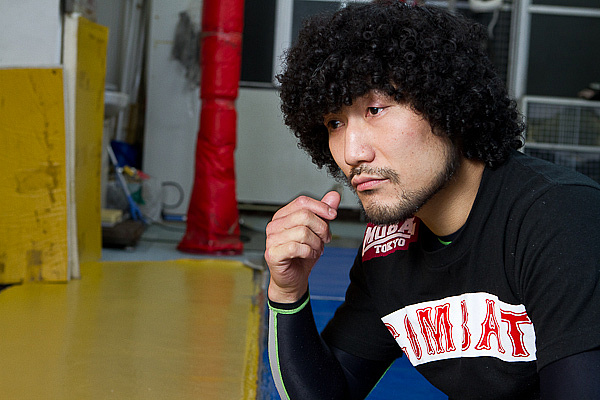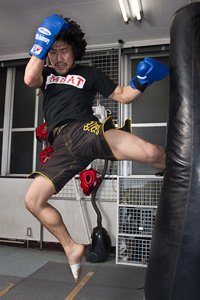The Afro Cometh -- Again
Again
Tony Loiseleur May 5, 2011

Mamoru Yamaguchi rocks an afro in honor of Japanese boxer Yoko
Gushiken. | Taro Irei/Sherdog.com
YOKOHAMA, Japan -- There is perhaps no more iconic a symbol of Shooto than Mamoru Yamaguchi and his afro, every bit as puffy as Shooto’s gloves.
Only recently departing the comfy confines of a Korakuen Hall to try his hand at stateside competition, the former two-time Shooto champion and current King of the Cage 125-pound titlist is making his journey stateside at an interesting time -- one in which flyweight has become the next division for hardcore fans to entreaty the UFC to patronize.
Advertisement
Luck and fate allowing, he will put on a performance worthy of getting himself on the UFC’s radar.
The last time
I spoke at length with Yamaguchi was just before his rematch
with Shinichi
Kojima for the Shooto 123-pound world title. He had become
Shooto’s first owner of the 123-pound strap after losing the
132-pound title to Masahiro
Oishi in 2001, during his days without the afro. After making
the cut, he reigned as 123-pound champ for almost three years until
losing to “BJ” by way of rear-naked choke in 2006.
In the rubber match, Yamaguchi battered Kojima from pillar to post until the last two minutes of the final round when, somewhat carelessly, the Shooto star stuck himself into a guillotine. It was by all appearances one from which he could have escaped if only his afro was not so big. Still, high-profile losses being as revelatory as they are life-altering, the shackles of chasing Shooto gold were suddenly lifted from the former two-time, two-division champion.
“The chance to fight [Kojima] as the challenger came, and, again, I lost. These losses changed my way of thinking,” Yamaguchi reflects matter-of-factly. “I wanted to try fighting somewhere else. Since I’d already fought so many of the fighters in my division [in Shooto], the only way I figured I could improve was to challenge myself under different rules.”
Yamaguchi’s long struggle to retain and recapture the title put him in Shooto’s trifecta of top 123-pound contenders between 2003 and 2008. It is a party amongst which the title has been exclusively traded for almost the past decade. Between defeating and dropping fights to grappling wunderkind Kojima and slick counter-striker and current champion Yasuhiro Urushitani, Yamaguchi has been in a redundant top-ranked holding pattern within Shooto.
“[Kojima] vacated the title, and Urushitani eventually took it. We three have fought each other quite a few times, and I was thinking, ‘Yeah, it’s about enough by now, isn’t it?’” he asks with a smirk.
Spending five years on top may not sound like a problem -- contrarily, it sounds like a blessing for any MMA fighter in a sport where such competitive longevity is a rarity. However, long-term dominance of this kind is anathema to the Shooto ideal, which is to raise fighters from the amateur ranks to the professional level. In a sense, fighters can be too effective, becoming potential prospect killers should they continue to stick around. This was reflected in Yamaguchi’s blowouts of up-and-coming Shootors such as Yuki Shojo and Masaaki Sugawara.
Simply put, it was time to move on for the afro’d Shooto ace.
“I actually wanted to fight [in the States] for a long time, so going through Shoot Boxing, where they had elbows, helped a lot in teaching me how to use them and how to defend against them. King of the Cage was also good exercise, this time in American rules and in fighting in a cage. I always thought my future would be in a cage under American rules, so it was good to be there,” he says.

T.
Irei
Yamaguchi is an explosive striker.
“I ate one on the crown of my head in a Shoot Boxing fight and thought, ‘Man, that really hurts.’ So yeah, they’re effective. It was bone on bone and was so hard that I was afraid I’d been cut. My head was really hot, so I reached up thinking, ‘Oh no, I’ve been cut.’ But there wasn’t any blood, and so I thought, ‘Oh, thank goodness’,” he recalls with laugh.
Adding elbows to a Japanese fighter’s game has always been rare and problematic at best. However, Yamaguchi’s case is unique in that he not only picked up the weapon relatively quickly through Shoot Boxing but also saw its practical use as a way to add versatility to his clinch game.
This became evident in his King of the Cage debut in early 2010, when the show made a stop in Okinawa. In his first cage and unified rules bout, Yamaguchi first crushed Frank Baca with short elbows before choking him out to win the promotion’s 125-pound title.
“I didn’t know how it happened, but the opportunity came and I was thrilled to think, ‘If I win, I’ll get a belt, and then I can go to the States and fight as a defending champion,’” recalls Yamaguchi. “I feel very lucky that I got to fight in Okinawa for my first fight under American rules, rather than having to fight abroad. That would’ve been far more difficult.”
Yamaguchi came stateside seven months later in Highland, Calif. In what was supposed to be his first KOTC title defense, he bashed an overweight Greg Guzman with his new favorite weapon: elbows. Despite the win, making the transition to stateside fighting has not been the easiest change for him, though it was not the rules or the cage that proved difficult. While most fighters are loath to bring it up, travel proved to be his most difficult adversary.
“I finally came to appreciate jet lag, which is something I’d never experienced but always hear foreign fighters claiming they got when they came to Japan. It’s something that I tried not to take much notice of and just tried to relax through it for the sake of the fight, but at night, I’d wake up at odd hours. Keeping your conditioning under those circumstances was difficult,” he says, somewhat embarrassed.
“Conditioning, different food, the time difference, and, of course, the language barrier I think are the biggest differences,” he elaborates. “I felt a little nervous if there wasn’t anyone who could speak Japanese around me while I was there.”
Japanese fighters, especially those on the regional level, almost never travel to vastly different time zones. Given that Tokyo often provides all Japanese fighters need career-wise, the opportunity to travel beyond the familiarity of one’s geographical and cultural comfort zone is rare. Further, at 33 years of age it is understandable why Yamaguchi has found it difficult to adapt.
“I don’t mean for these to be excuses. When you step into the cage, you still have to be at your best and you still have to win,” he says. “In order to be victorious in America, I just need to be stronger mentally. I promised to study how the rules and judges in America execute fights. I think not being prepared for these things is one of the reasons why other Japanese fighters aren’t doing well there.”
“Of course, another reason is that the level of American fighters is higher, probably the highest in the world,” he concedes.
Finish Reading » Touch of Shooto
Related Articles







